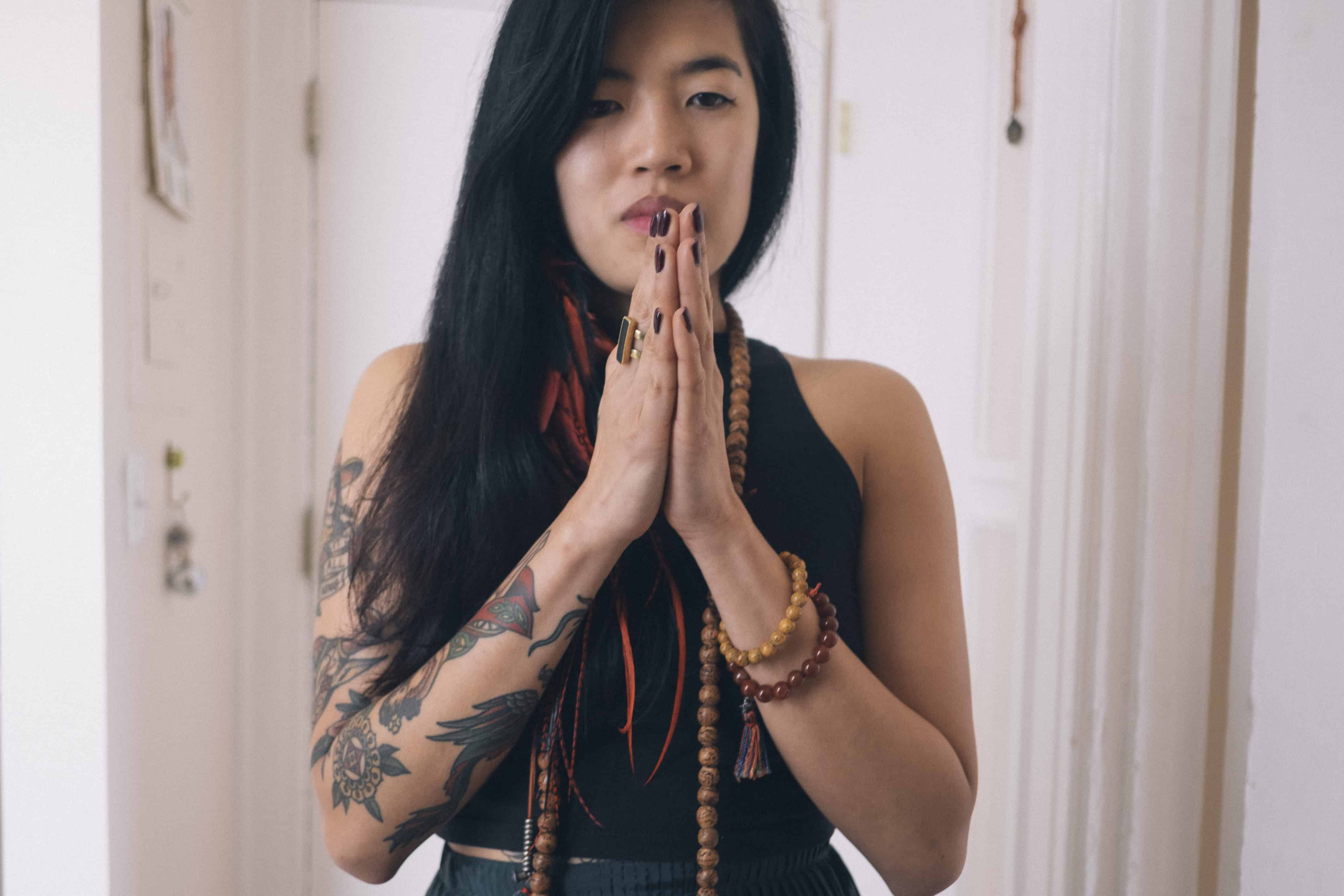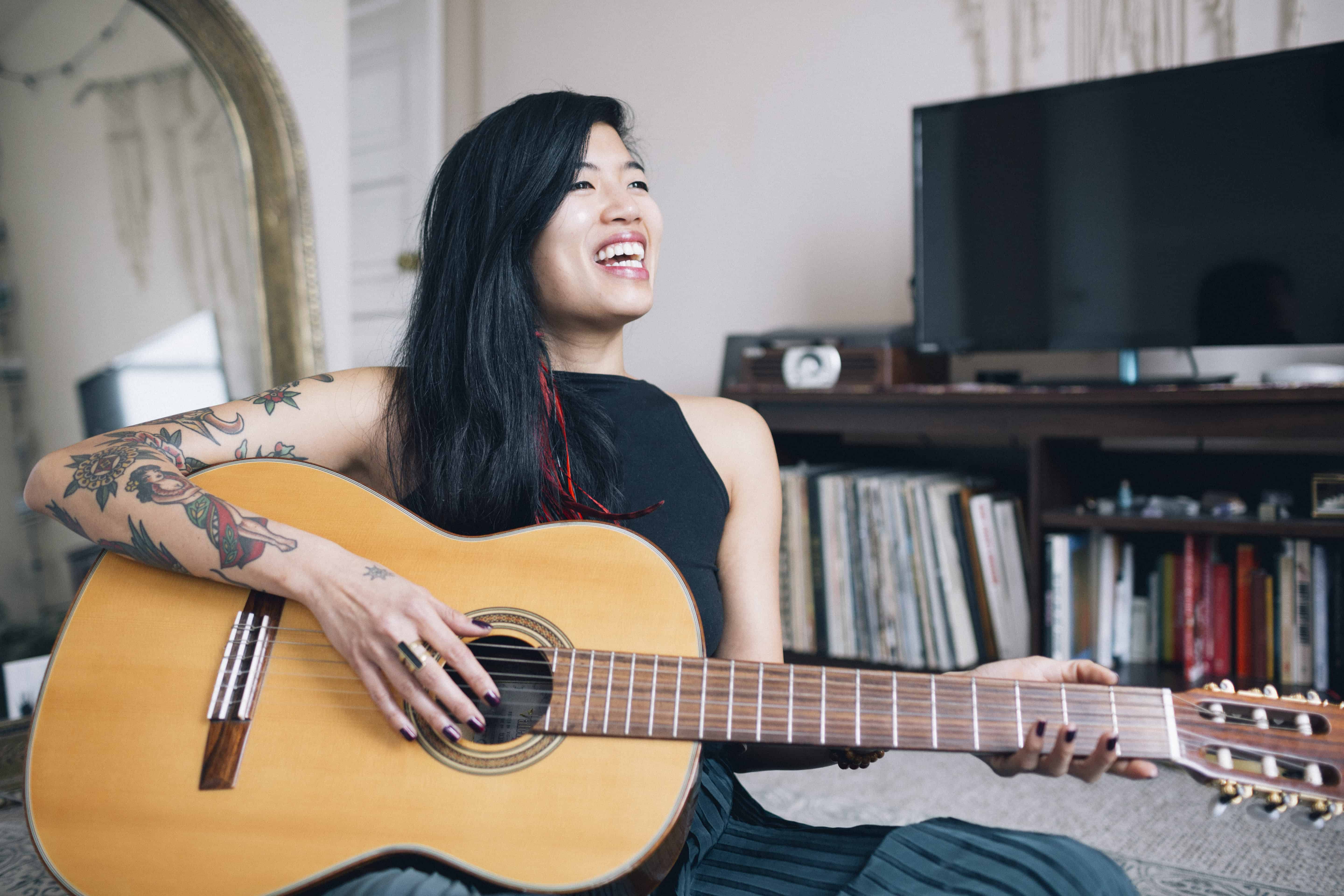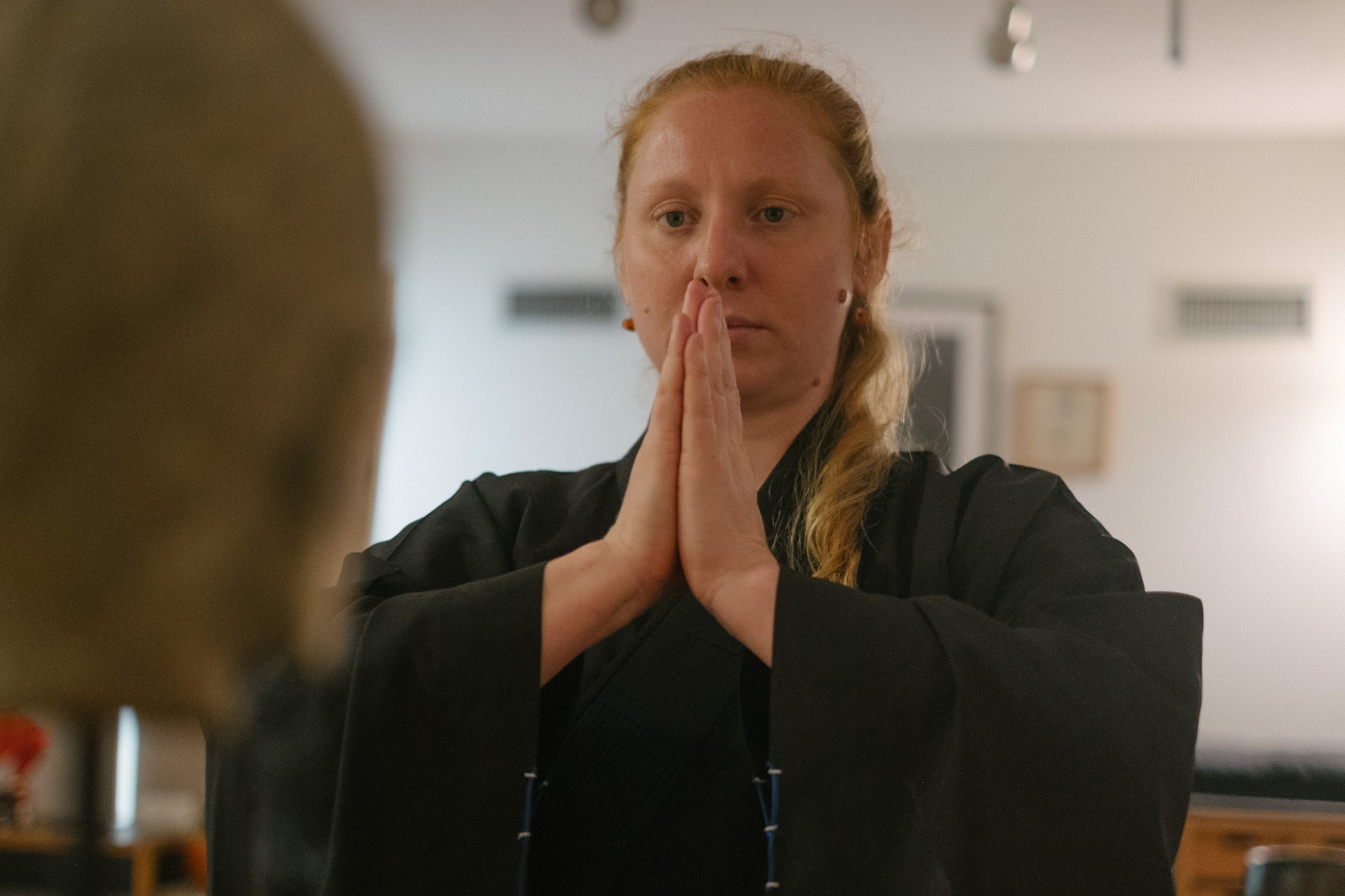When were you first exposed to dharma?
I had the blessing to be born in a dharma household where my parents volunteered to host weekly meditation sittings in our home for a local Vipassana organization in Hawaii. We recited the three refuges in pali every night before I went to bed. Monks like Munindra and Sayadaw U Pandita would come to stay with us when I was growing up. Even Joseph Goldstein came to my home before I was old enough to appreciate his teachings. Though I sat off and on my whole life and did many day long retreats in my teenage years, it was my first 3 day residential retreat on the North Shore of O’ahu where I had my first deep transformative sitting- on the last day I had an experience of being perfectly at peace with myself exactly the way I was. As an insecure and awkward late bloomer this was a huge breakthrough. I did a 7 day Vipassana retreat in Burma two years later and had the same experience on the 5th day- total ease and equanimity with myself and the world. From there my dedication to this path deepened and solidified.
How has the path manifest in your daily experience? Does it reflect in your work and relationships?
There’s literally no part of my daily experience that isn’t influenced by the dharma and my mindfulness practice. It is my trust in the freedom and beauty available in each present moment, especially since taking my Year To Live class and meditating on our impermanence, that guides my heart and mind throughout the day. When I take the time to set aside my phone look at the world around me I find every day little sights and interactions profoundly moving: two friends on the sidewalk in an extra long embrace, the light peeking through leaves on a tree, the pink and purple hues of the sky as the sun rises and sets, the taste of a juicy strawberry. This trust and practice grounds me in chaotic moments throughout my work day when I remember to step back and breathe. It gives me patience when I encounter challenges with people in my life and also allows me to open my heart wide and tune in to the love I feel for not just my friends, family and sangha but every being (big and small) I pass on the street, sit next to on the bus.
Who is your teacher(s)?
I’ve been fortunate enough to have many wise and compassionate dharma teachers in my life, some who were like aunties and uncles growing up in Hawai’i, some who became friends, all who continue to inspire me with their dedication, their knowledge, their love, their authenticity, most notably Michele McDonald, Steve Smith, Graham White, Gavin Harrison, Kamala Masters, Lynne Bousfield, Trudy Goodman, Noah Levine, Matthew Brensilver, Vinny Ferraro and Gene Lushtak. They’ve shown me that my teacher can be any person anywhere any time- a challenging and confrontational individual, a beggar in the street, each has the ability to open my eyes to a greater truth and dig deep within myself to open my heart even in moments of doubt or anger or confusion or sadness.
How long/often do you mediate?
I wish I was sitting for an hour a day morning and night but my daily sitting practice doesn’t generally last more than 10-15 minutes; I try to attend the weekly sitting groups at Against The Stream at least once a week which last about 30-40 minutes
Which sangha do you normally attend?
I’ve been sitting with Against The Stream for over 10 years now.
What is your primarily profession?
I’m a filmmaker/photographer/one-woman production crew
Was there an experience in your life where you realize the profound power of the practice?
This practice has helped me through every difficult experience I’ve ever had. I once broke up with a boyfriend in the middle of a day long retreat and went back to finish it; I needed the solace of the dharma in that moment more than ever. I also went through months of heavy depression in 2010 following a brief manic episode during which I had been diagnosed as bipolar. It was to this day the most painfully confusing time of my life. Though it was difficult to practice during those months mindfulness did provide me with a bit of space during moments when my depression became too heavy. With meditation and regular exercise I’ve been able to stay off medication for years and retain a stable mental and emotional balance.
Background
Kim’s journey into Buddhist practice began at a young age, influenced by the background of both parents being Vipassana meditation teachers. From infancy, Kim’s family welcomed individuals every Sunday for meditation sessions led by a Dharma teacher. Buddhism and mindfulness were constants in Kim’s life, even before a full comprehension of their significance. Kim started meditating sporadically from a tender age of seven or eight but didn’t delve into it seriously until the end of high school when attending a residential retreat. On the third day of the retreat, a profound shift occurred, bringing about a sense of self-acceptance and ease with oneself. This transformation was particularly impactful for Kim, who had struggled with late blooming, awkwardness, and low self-esteem throughout high school. The experience marked the beginning of a deep connection with Buddhist practice.
Fruit of practice
Kim recently witnessed a profound transformation in her father’s life when he endured a challenging experience, suffering a stroke that led to time in the ICU and subsequent chemotherapy. Despite the hardships, Kim was inspired by her father’s remarkable composure and grace throughout the healing process. When questioning him about fear, he referred to the teachings of Buddhism, emphasizing that aging and dying are intrinsic parts of life.
This experience motivated Kim to continue her own mindfulness practice. Observing her parents’ ability to navigate difficult emotions and life’s challenges with tools gained through decades of practice left a lasting impact. Comparing her life to those seemingly accomplished in their fields, Kim acknowledged that her mastery lies in living with profound ease. She reflected on the confidence instilled by her practice, knowing she can face any crisis and find moments of ease through life’s difficulties. Kim attributes this assurance to her teachers, years of practice, and a commitment to self-discovery.
Beyond mindfulness, Kim explored various practices such as landmark education, recognizing the interconnectedness of these approaches. For her, mindfulness is the ability to empower oneself through life’s challenges, understanding that circumstances are what they are, and the rest is a narrative created by the mind. Kim’s life is her masterpiece, an ongoing evolution where she acknowledges she hasn’t mastered it entirely but has the confidence to navigate the complexities of life.
Teachers
Kim holds Vinnie Ferraro in high regard as one of her favorite teachers in San Francisco, appreciating the love he radiates during his teachings. Vinnie has overcome significant challenges, including jail time, addiction, and the dramatic loss of his mother at a young age. Despite his hardships, Vinnie has maintained self-love and equanimity, sharing these qualities with others.
Kim emphasizes the cyclical nature of Dharma talks, noting that while the teachings remain consistent, their impact varies as individuals evolve. Teachers like Vinnie inspire Kim to persevere in her practice by embodying the teachings in their lives. Kim values the authenticity of teachers who openly acknowledge their struggles with ego and other common human challenges. The collective journey of practicing together and supporting one another has a profound impact on Kim.
Expressing gratitude for her teachers, Kim highlights their ability to provide insights and guidance during times of uncertainty. She hopes to share the wisdom gained from her teachers with others and continue living it herself. Kim recognizes that teachers, like everyone else, are not infallible and should not be placed on pedestals. She draws parallels to the Buddha, emphasizing that the teachings are accessible to all, and the cultivation of Buddha nature is within everyone.
In conclusion, Kim stresses the equality among individuals on the spiritual journey, highlighting that teachers can learn from their students as much as students can learn from teachers, fostering a sense of unity and shared growth in the spiritual community.
Sangha
Kim emphasizes the importance of finding a Sangha, or community, when she left Hawaii to continue her mindfulness practice. She discovered Insight L.A. and met Trudy Goodman during her time at Loyola Marymount. Kim also became involved with Noah Levine’s group, Against the Stream, in Los Angeles and continued with them when she moved to San Francisco.
Reflecting on the challenges faced by her Sangha, Kim acknowledges the impermanence of the containers of practice while emphasizing the timeless nature of the teachings. She shares the heartbreak of witnessing a sacred and safe space disintegrate, particularly impactful for those newer to the practice, especially those seeking recovery from addiction and trauma.
In a broader context, Kim discusses the challenges that arise in Western mindfulness practice, pointing out the need for more support and structures for teaching and Sangha. She highlights the importance of addressing power dynamics and ego checks for teachers, emphasizing the need for continuous self-reflection.
Kim expresses hope for a collective learning experience in the wake of MeToo revelations, where communities can come together to discuss and implement measures to maintain safety. She stresses the value of having a teacher and Sangha to turn to during challenging periods, providing reminders of forgotten lessons and holding individuals accountable in their practice.
Recognizing the difficulty of turning inward and being with oneself, Kim values the support of a community that helps keep her motivated and less alone on the path. She speaks about the profound impact of shared energy in group meditation, emphasizing the unique power of sitting together as a community. Kim concludes by highlighting the need for support, encouragement, and accountability in navigating the challenges of mindfulness practice.
Relationships
Kim reflects on the challenges of maintaining a healthy romantic relationship, acknowledging the difficulty of letting go of past mistakes and approaching each day with a fresh perspective. She emphasizes the value of mindfulness practice in starting anew and avoiding the trap of dwelling on past grievances. Kim sees parallels between the effort required in a successful relationship and the dedication needed for mindfulness practice.
Highlighting the importance of vulnerability and the willingness of both partners to begin again each day, Kim recognizes that building a strong relationship takes effort over time. She cautions against the tendency to walk away when things get tough, emphasizing that facing challenges is crucial for developing a lasting connection.
In terms of partner selection, Kim admits a desire for a partner dedicated to the practice but acknowledges that different paths can lead to personal growth. She warns against the ego trap of assuming greater evolution due to one’s own meditation practice and stresses the diversity of approaches individuals take to awaken and evolve.
Ultimately, Kim underscores the need for effort, dedication, and a commitment to being present in a relationship. Letting go of past resentments and embracing love and presence are essential tools for creating a beautiful connection between two people.
Other Religions
Kim reflects on the evolution of her mindfulness practice in the past year and a half, particularly during moments of heartbreak and loss, mostly in the realm of romantic relationships. As someone raised in a Buddhist household, the concept of God was unfamiliar, and the term itself carried heavy baggage due to historical associations with oppression.
However, during difficult times, Kim found herself drawn to the idea of a relationship with God, a shift influenced by teachings on fierce grace and the potential for vulnerability to connect one with a higher power. Despite reservations about the term “God,” Kim acknowledges the universality of the connectedness she experiences during meditation, describing it as a sense of oneness that could be labeled as God, the universe, or universal connectedness.
Kim emphasizes the interconnectedness of various spiritual traditions, inspired by the Dalai Lama’s message not to abandon one’s own practice for conversion. She shares a newfound openness to prayer and a relationship with God, recognizing that different practices can coexist and complement each other. This shift in perspective has led Kim to feel more connected to those from different faiths, dispelling the ego-centric notion that one’s own path is superior.
The idea of wanting a relationship with God doesn’t diminish Kim’s belief in turning inward for equanimity. Instead, it broadens her approach, allowing her to choose different practices depending on the moment—whether it’s Metta, prayer to God, or mindfulness meditation. Kim encourages others to explore various spiritual practices, emphasizing the diversity of paths that can lead to personal growth and connection.
Mental Health
Kim shares her experience of practicing mindfulness for about seven years before being diagnosed with bipolar disorder. Despite the inherent difficulty of meditating during depressive episodes, she acknowledges that even brief moments of presence and mindfulness create a sense of ease amid the heaviness of depression. Kim emphasizes the significance of the effort to begin again and again, recognizing any moment of relief as a form of grace.
After achieving stability over the years, Kim finds value in mindfulness not only for grounding herself but also for maintaining self-awareness. Being mindful enables her to sense imbalances, increased tension, or heightened anxiety, prompting her to slow down and implement self-care measures. Kim stresses the importance of self-awareness in mental health, emphasizing the need to check in with oneself regularly, nurturing the ability to provide the necessary self-care and maintain a balanced mental state.
Worldview
Kim shares how her mindfulness practice instills in her a profound sense of interconnectedness with all beings, fostering compassion for the world. This extends beyond humans to encompass all creatures and life forms on the planet. Concerned about the current state of environmental destruction, Kim emphasizes the importance of recognizing our interconnectedness and understanding that every action has an impact.
Motivated by the belief that every life is valuable and precious, Kim advocates for conscious actions in daily life to reduce environmental damage. This includes simple steps like using less water and consuming less meat. She acknowledges the challenges posed by societal pressures, such as materialistic ideals promoted on social media, but emphasizes the need to slow down and reassess true values.
Kim discusses the trend of minimalism and how her generation is turning away from materialistic values, valuing experiences over possessions. She sees social media as a platform to spread messages of mindfulness and encourages living a life beyond oneself. Mindfulness, according to Kim, is crucial for reflecting on the impact of one’s actions, cultivating self-awareness, and avoiding destructive behaviors driven by ego or insecurity.
In essence, Kim believes that mindfulness practice is vital for cultivating interconnectedness, compassion, and self-awareness. By recognizing our global interconnectedness and living in harmony with the planet, she believes mindfulness can contribute to a sustainable and harmonious future for all.















































































